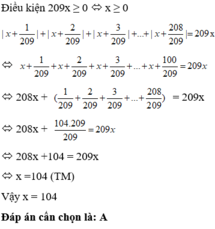

Hãy nhập câu hỏi của bạn vào đây, nếu là tài khoản VIP, bạn sẽ được ưu tiên trả lời.



Câu 1a : tự kết luận nhé
\(2\left(x+3\right)=5x-4\Leftrightarrow2x+6=5x-4\Leftrightarrow-3x=-10\Leftrightarrow x=\frac{10}{3}\)
Câu 1b : \(\frac{1}{x-3}-\frac{2}{x+3}=\frac{5-2x}{x^2-9}\)ĐK : \(x\ne\pm3\)
\(\Leftrightarrow x+3-2x+6=5-2x\Leftrightarrow-x+9=5-2x\Leftrightarrow x=-4\)
c, \(\frac{x+1}{2}\ge\frac{2x-2}{3}\Leftrightarrow\frac{x+1}{2}-\frac{2x-2}{3}\ge0\)
\(\Leftrightarrow\frac{3x+3-4x+8}{6}\ge0\Rightarrow-x+11\ge0\Leftrightarrow x\le11\)vì 6 >= 0
1) 2(x + 3) = 5x - 4
<=> 2x + 6 = 5x - 4
<=> 3x = 10
<=> x = 10/3
Vậy x = 10/3 là nghiệm phương trình
b) ĐKXĐ : \(x\ne\pm3\)
\(\frac{1}{x-3}-\frac{2}{x+3}=\frac{5-2x}{x^2-9}\)
=> \(\frac{x+3-2\left(x-3\right)}{\left(x-3\right)\left(x+3\right)}=\frac{5-2x}{\left(x-3\right)\left(x+3\right)}\)
=> x + 3 - 2(x - 3) = 5 - 2x
<=> -x + 9 = 5 - 2x
<=> x = -4 (tm)
Vậy x = -4 là nghiệm phương trình
c) \(\frac{x+1}{2}\ge\frac{2x-2}{3}\)
<=> \(6.\frac{x+1}{2}\ge6.\frac{2x-2}{3}\)
<=> 3(x + 1) \(\ge\)2(2x - 2)
<=> 3x + 3 \(\ge\)4x - 4
<=> 7 \(\ge\)x
<=> x \(\le7\)
Vậy x \(\le\)7 là nghiệm của bất phương trình
Biểu diễn
-----------------------|-----------]|-/-/-/-/-/-/>
0 7

\(\frac{x}{2\left(x-3\right)}+\frac{x}{2\left(x+1\right)}=\frac{2x}{\left(x+1\right)\left(x-3\right)}\left(x\ne3;x\ne-1\right)\)
\(\Leftrightarrow\frac{x\left(x+1\right)}{2\left(x-3\right)\left(x+1\right)}+\frac{x\left(x-3\right)}{2\left(x-3\right)\left(x+1\right)}-\frac{2x\cdot2}{2\left(x-3\right)\left(x+1\right)}=0\)
\(\Leftrightarrow\frac{x^2+x+x^2-3x-4x}{2\left(x-3\right)\left(x+1\right)}=0\)
\(\Leftrightarrow\frac{2x^2-6x}{2\left(x-3\right)\left(x+1\right)}=0\)
\(\Leftrightarrow\frac{2x\left(x-3\right)}{2\left(x-3\right)\left(x+1\right)}=0\)
=> 2x=0
<=> x=0
Vậy x=0
+ Ta có: \(\frac{x}{2.\left(x-3\right)}+\frac{x}{2.\left(x+1\right)}=\frac{2x}{\left(x+1\right).\left(x-3\right)}\)\(\left(ĐKXĐ: x\ne-1, x\ne3\right)\)
\(\Leftrightarrow\frac{x.\left(x+1\right)+x.\left(x-3\right)}{2.\left(x-3\right).\left(x+1\right)}=\frac{4x}{2.\left(x-3\right).\left(x+1\right)}\)
\(\Rightarrow x^2+x+x^2-3x=4x\)
\(\Leftrightarrow\left(x^2+x^2\right)+\left(x-3x-4x\right)=0\)
\(\Leftrightarrow2x^2-6x=0\)
\(\Leftrightarrow2x.\left(x-6\right)=0\)
\(\Leftrightarrow\orbr{\begin{cases}x=0\\x-6=0\end{cases}}\Leftrightarrow\orbr{\begin{cases}x=0\left(TM\right)\\x=6\left(TM\right)\end{cases}}\)
Vậy \(S=\left\{0,6\right\}\)
+ Ta có: \(\frac{1}{x-1}+\frac{2}{x^2+x+1}=\frac{3x^2}{x^3-1}\)\(\left(ĐKXĐ:x\ne1,x^2+x+1\ne0\right)\)
\(\Leftrightarrow\frac{\left(x^2+x+1\right)+2.\left(x-1\right)}{\left(x-1\right).\left(x^2+x+1\right)}=\frac{3x^2}{\left(x-1\right).\left(x^2+x+1\right)}\)
\(\Rightarrow x^2+x+1+2x-2=3x^2\)
\(\Leftrightarrow\left(x^2-3x^2\right)+\left(x+2x\right)+\left(1-2\right)=0\)
\(\Leftrightarrow-2x^2+3x-1=0\)
\(\Leftrightarrow2x^2-3x+1=0\)
\(\Leftrightarrow\left(2x^2-2x\right)-\left(x-1\right)=0\)
\(\Leftrightarrow2x.\left(x-1\right)-\left(x-1\right)=0\)
\(\Leftrightarrow\left(2x-1\right).\left(x-1\right)=0\)
\(\Leftrightarrow\orbr{\begin{cases}2x-1=0\\x-1=0\end{cases}}\Leftrightarrow\orbr{\begin{cases}2x=1\\x=1\end{cases}}\Leftrightarrow\orbr{\begin{cases}x=\frac{1}{2}\left(TM\right)\\x=1\left(L\right)\end{cases}}\)
Vậy \(S=\left\{\frac{1}{2}\right\}\)

Câu d : \({2x \over x+1}\) + \({18\over x^2+2x-3}\) = \({2x-5 \over x+3}\)
a) \(x^4+2x^3-3x^2-8x-4=0\)
\(\Leftrightarrow x^4+2x^3-3x^2-6x-2x-4=0\)
\(\Leftrightarrow x^3\left(x+2\right)-3x\left(x+2\right)-2\left(x+2\right)=0\)
\(\Leftrightarrow\left(x+2\right)\left(x^3-3x-2=0\right)\)
\(\Leftrightarrow\left(x+2\right)\left(x^3-4x+x-2=0\right)\)
\(\Leftrightarrow\left(x+2\right)\left[x\left(x^2-4\right)+\left(x-2\right)\right]=0\)
\(\Leftrightarrow\left(x+2\right)\left[x\left(x-2\right)\left(x+2\right)+\left(x-2\right)\right]=0\)
\(\Leftrightarrow\left(x+2\right)\left(x-2\right)\left(x^2+2x+1\right)=0\)
\(\Leftrightarrow\left(x+2\right)\left(x-2\right)\left(x+1\right)^2=0\)
\(\Leftrightarrow\orbr{\begin{cases}x=\pm2\\x=-1\end{cases}}\)
Vậy tập nghiệm của phương trình là \(S=\left\{\pm2;-1\right\}\)
b) \(\left(x-2\right)\left(x+2\right)\left(x^2-10\right)=0\)
\(\Leftrightarrow x-2=0\)hoặc \(x+2=0\)hoặc \(x^2-10=0\)
\(\Leftrightarrow x=2\)hoặc \(x=-2\)hoặc \(x=\pm\sqrt{10}\)
Vậy tập nghiệm của phương trình là : \(S=\left\{\pm2;\pm\sqrt{10}\right\}\)
c) \(2x^3+7x^2+7x+2=0\)
\(\Leftrightarrow2x^3+2x^2+5x^2+5x+2x+2=0\)
\(\Leftrightarrow2x^2\left(x+1\right)+5x\left(x+1\right)+2\left(x+1\right)=0\)
\(\Leftrightarrow\left(x+1\right)\left(2x^2+5x+2\right)=0\)
\(\Leftrightarrow\orbr{\begin{cases}x+1=0\\2x^2+5x+2=0\end{cases}}\Leftrightarrow\orbr{\begin{cases}x=-1\left(tm\right)\\2\left(x+\frac{5}{4}\right)^2+\frac{7}{16}=0\left(ktm\right)\end{cases}}\)
Vậy tập nghiệm của phương trình là \(S=\left\{-1\right\}\)
d) Xem lại đề


a) 8x - 3 = 5x + 12
<=> 8x - 5x = 12 + 3
<=> 3x = 15
<=> x = 5
b) \(\frac{x}{x^2-4}=\frac{1}{x+2}-\frac{1-x}{2-x}\) ; x khác +-2
<=> \(\frac{x}{\left(x-2\right)\left(x+2\right)}=\frac{1}{x+2}-\frac{1-x}{2-x}\)
=> x(2 - x) = (x - 2)(2 - x) - (1 - x)(x + 2)(x - 2)
<=> -x^2 + 2x = x^3 - 2x^2
<=> -x^2 + 2x - x^3 + 2x^2 = 0
<=> x^3 - x^2 - 2x = 0
<=> x(x + 1)(x - 2) = 0
<=> x = 0 hoặc x + 1 = 0 hoặc x - 2 = 0
<=> x = 0 (tm) hoặc x = -1 (tm) hoặc x = 2 (ktm)
Vậy: phương trình có tập nghiệm: S = {0; -1}
c) |x - 5| = 3x + 1
Ta có: \(\left|x-5\right|=\hept{\begin{cases}x-5\text{ nếu }x-5\ge0\Leftrightarrow x\ge5\\-\left(x-5\right)\text{ nếu }x-5< 0\Leftrightarrow x< 5\end{cases}}\)
+) Nếu x > 5, ta có phương trình:
x - 5 = 3x + 1
<=> x - 3x = 1 + 5
<=> -2x = 6
<=> x = -3 (ktm)
+) Nếu x < 5, ta có phương trình:
-(x - 5) = 3x + 1
<=> -x + 5 = 3x + 1
<=> -x - 3x = 1 - 5
<=> -4x = -4
<=> x = 1 (tm)
Vậy: phương trình có tập nghiệm: S = {1}

ĐK : 2x - 1 \(\ge0\)=> \(x\ge\frac{1}{2}\)
Khi đó |2x - 1| = 2x - 1
<=> \(\orbr{\begin{cases}2x-1=2x-1\\2x-1=-2x+1\end{cases}}\Leftrightarrow\orbr{\begin{cases}0x=0\\4x=2\end{cases}}\Leftrightarrow\orbr{\begin{cases}\forall x\\x=\frac{1}{2}\end{cases}}\Leftrightarrow\forall x\)
Kết hợp điều kiện => \(x\ge\frac{1}{2}\)là giá trị phải tìm
Vậy \(x\ge\frac{1}{2}\)là nghiệm phương trình
=> Chọn B